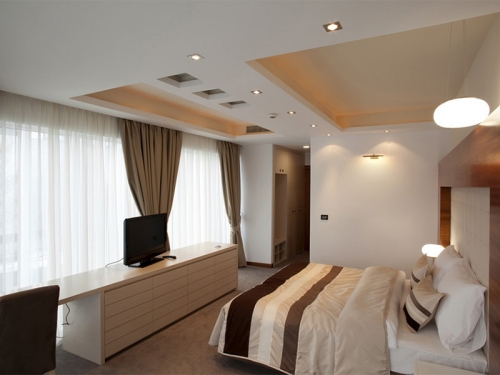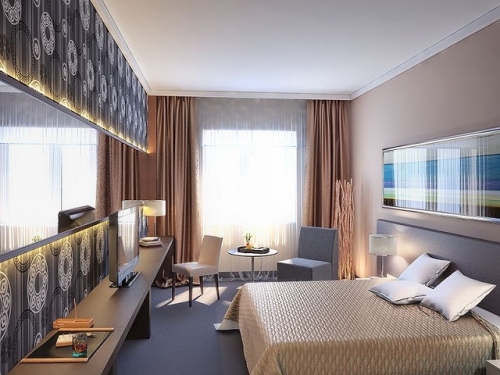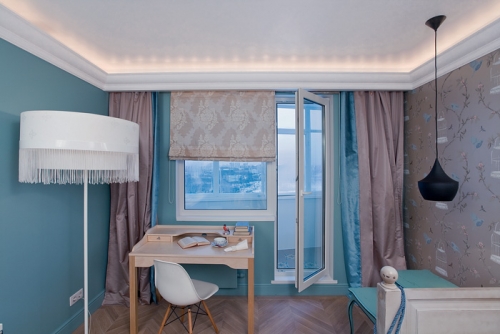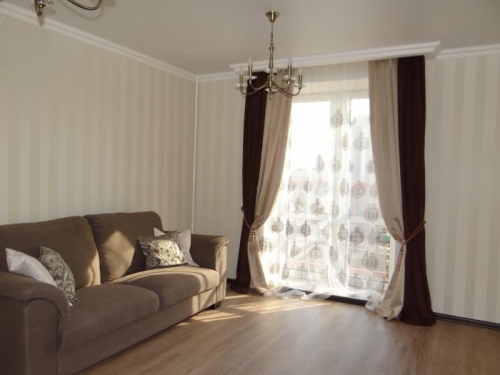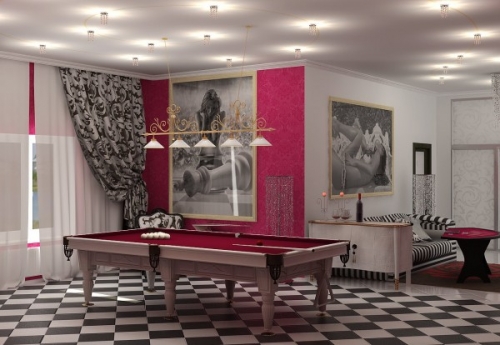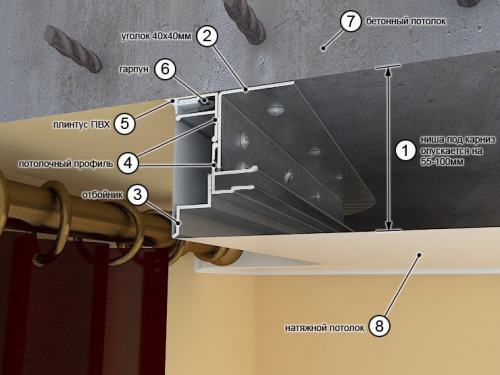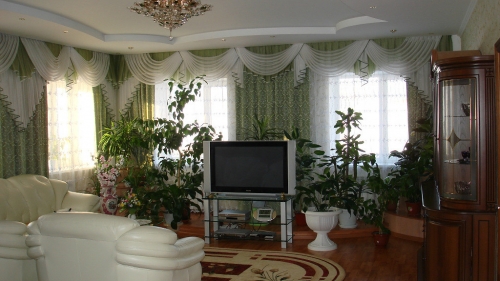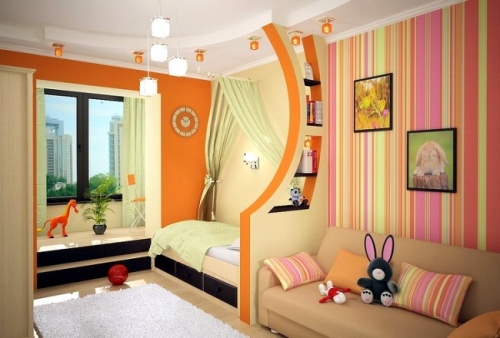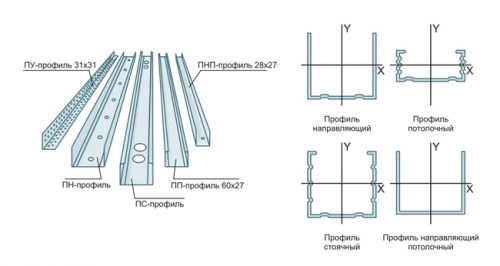Low -rise houses with a residential attic are more common. First of all ...
|
|
The basement in the house acts as an additional air gap, ... |
When arranging a dwelling, it is not the last place to vapor barrier of the walls and ... |
Hidden cornice for curtains: installation features
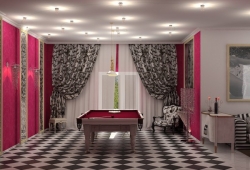
A thoroughly thought -out interior of the room and competently selected secondary design components of the key to creating the harmonious beauty of your home. And if we are talking about the design of the living room and especially the bedrooms, one of the main components of the harmonious interior is window and doorways. Each master, whether he is a pros or a beginner, will agree that it is difficult to overestimate the role of curtains in the interior of the room. However, their inalienable element, the cornice does not always fit into the general stylistic solution of the room, and therefore, there is a completely appropriate desire to hide it, which will not affect its functionality. This is due to the fact that the cornices for curtains, first of all, are a functional element of the structure, and only after that they are given a certain decorative load. In this regard, if you plan to create a harmonious and impressive interior, hiding minor flaws, and want to design the window opening so that nothing distracts the contemplation of the game of light in massive or weightless cloths of fabric, pay attention to the hidden cornice for the curtains, the installation of which will make your dreams to realize. When there is a need to install these designs and what are their features, as well as what the advantages of curtains with a hidden cornice are and how strong their interior potential is the main questions of our readers, who have stopped their choice on hidden cornices. Given the relevance of this topic, we will try to answer these questions, and also consider several options for installing hidden cornices.
Content
- When does the need to arrange hidden cornices arise?
- The advantages of hidden cornices
- Selection and operation of hidden cornices: practical recommendations
- Hidden cornice for curtains in a stretch ceiling: features and installation
- How to make a hidden cornice: arrangement of a plasterboard niche
When does the need to arrange hidden cornices arise?
The popularization of hidden cornices for curtains, which occurs in modern design, is due to several fundamental reasons that will be called below.
1. Functional need to create harmonious design. Often the need to use a hidden cornice occurs in rooms decorated with stretch ceilings. This is due to the fact that on the surface of the stretch ceiling it is forbidden to mount any protruding rigid structures that can lead to damage to the ceiling film. It is logical that in this case traditional ceiling cornices cannot be used. As for the wall-mounted fastening version, it must also be safe for the PVC film of the stretch ceiling, and therefore, we conclude that the structural elements of the cornice should not in no way contact with PVC film. The most optimal and functional solution to this problem is the installation of a hidden cornice;
2. The interior without flaws and the desire to observe the fundamental principles of modern design Another reason why the installation of a hidden cornice is carried out. An elegant design technique, which has become especially relevant recently, is decorating window openings with curtain canvases flowing directly from the ceiling without any additional mounts. And if, in addition to everything else, they are decorated with backlight, then they are able to win the heart of even the most avid skeptic, which does not welcome non -standard decisions in design. To solve this problem, the master prefer to install drywall ceilings, which is also due to the undeniable advantages of this material. If you have made a choice in favor of a hidden cornice for gypsum plasterboard curtains, you get the opportunity to equip not only traditional straight cornices, but P-shaped, curved and even semicircular structures. However, in this case, it will be necessary to equip a niche in a drywall ceiling in order to hide the cornice with it. The installation technology of such a niche will be considered in this article;
Designers distinguish another type of hidden cornices the so -called baguette structures, which are a variety of traditional wall cornices. Features of their installation involve the camouflage of all the elements of the cornice under decorative pads made of wood, plastic or metal.
Hidden cornices for curtains photo
The advantages of hidden cornices
Practicality and aesthetics of the structure. Hidden ceiling cornices for curtains The most preferred option for fastening curtains in the room characterized by the presence of low ceilings. In such rooms, the installation of a traditional cornice will further reduce the height of the ceiling as opposed to the hidden cornice, which will allow you to effectively organize the space, making it more spacious and higher;
If there is enough for stretch ceilings in a room wide window sills, a traditional wall cornice may not approach them in width. Using a hidden cornice, you can hang any curtains regardless of the width of the window sill;
Additional design and functionality. The niche in which you hide the cornice is an additional place where you can hide the wiring, laying the fiber -optic line of the Internet, as well as ventilation and backlight. By arranging this niche, you can refuse to install additional structures for masking communications;
The formation of a single interior space and focusing on decor, cover and features of the design of curtains. The absence of additional fasteners will allow you not to be distracted from the atmosphere created by a flowing fabric. The arrangement of additional illumination in the niche of the stretch ceiling will emphasize the textile composition without being distracted by the light source;
This method of fastening textiles is ideal for any design solution. You will not have to select the cornice for door handles or to the color of furniture, search for decorative plugs for the cornice, and so on. Using a hidden cornice, you can not be distracted from your main task, the choice and design of curtains;
The ability to save. This is due to the fact that the aluminum cornice installed in the ceiling niche is much cheaper than that, in addition to the functional, it also solves the decorative problem, and therefore, decorated with carvings, forging and expensive metals, which cannot but affect its cost;

As for the advantages baguette cornices, then they are limited by them decorative design, which amazes with its diversity. When choosing baguette cornices, you can find everything that your soul wants: from laser engraving on a metal surface and wood threads to air acrylic structures and heavy bronze alloys.
Important! As for the shortcomings of hidden cornices, they include the need for additional installation works and, as a result, financial costs, as well as the difficulty of replacing hidden structures.

Selection and operation of hidden cornices: practical recommendations
It is no secret that the choice of even the most perfect and thoughtful design is characterized by its intricacies and nuances, the thorough observance of which will allow in the future to avoid unpleasant surprises.
- If you decide to give preference to a hidden cornice, experts recommend thinking through the design and design features of the curtains in advance. If you neglect these tips, then when choosing a cut and design of curtains, you will have to focus on the design features of the cornice, which will significantly complicate your task;
- In the process of installing a hidden cornice, focus on the width of the windowsill and heating devices under it. This is due to the fact that the curtains should not touch the batteries, and therefore, in the process of installing the cornice, it must be forwarded 1-2 cm from the windowsill;
- If you cannot boast of spacious rooms and plan to visually expand its space, during the installation of the cornice, do not limit yourself to the width of the windowsill and the window, but organize the cornice, the length of which corresponds to the length of the wall. Hanging the curtains along the entire width of the wall, you will make its space one, in connection with which, it will be perceived a little larger in area;
- If you prefer the bagulate cornice, during its installation process, all measurements are made along the width of its decorative part, which should freely fit into the wall space, and also not hang into the window opening and not rest against the ceiling;
- In the process of choosing a cornice, it is important to pay special attention to its functional elements by loops and runners. Their movement should be silent and free, in the process of movement they should not cling to the rails of the cornice.
Hidden cornice for curtains in a stretch ceiling: features and installation
A hidden cornice is one of the options for installing a cornice, which is a kind of tire attached to the ceiling and placed in a specially equipped niche, which is formed between the wall and the stretch ceiling. The resulting deepening is almost imperceptible even when you stand right under it. In connection with the constructive features of a hidden cornice, a non -standard design solution is created, when the curtains are practically soared in the air, which is especially relevant for low rooms, since the curtains visually increase the ceiling height.
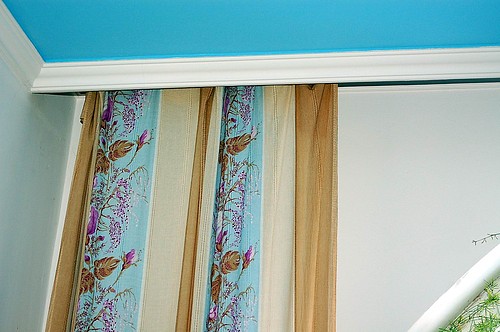
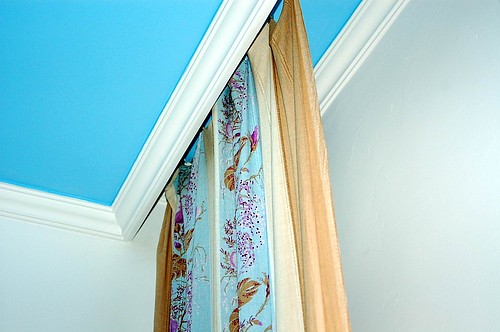
Features of the installation of a hidden cornice for curtains in a stretch ceiling:
At a distance of 20 cm from the wall in which the window opening is located, a furniture corner is attached to the base of the concrete ceiling plate, to which a wooden beam is subsequently mounted along the entire length. The middle of the beam is determined and the wall baguette is fixed in this place, which is necessary in order for the ceiling film to tighten and, as a result, hides an unsightly structure consisting of a beam and a furniture corner. The center of the resulting niche is determined and a hidden cornice is fixed in this place.
Important! The decorative design of a hidden cornice in the stretch ceiling does not matter, since it will be completely hidden from prying eyes. The main requirement presented to this element is the reliability of the mounting of the curtains, lightness, mobility and smoothness of the movement of rings and hooks on the cornice.
Important! You can diversify the interior design of your room or carry out competent zoning of the space by installing in the ceiling niche, where there is a hidden cornice, additional LED backlight. The most optimal with the task of dividing the space into functional zones will be a diode tape, which gives bright lighting and at the same time consuming a small amount of electricity.
How to make a hidden cornice: arrangement of a plasterboard niche
Using one of the modern finishing materials, drywall, which has a number of undeniable advantages, you can realize your most daring design ideas, one of which is the arrangement of the cornice. However, given its slight strength and inability to withstand heavy weight loads, suspension of ceilings and walls trimmed with drywall, heavy structures become difficult. The solution to this problem was found, and the masters unanimously stated that the only right exit from this situation is the arrangement of ceiling niches in which the cornices will be installed. In this regard, the masters are quite rightful as they ask the question: how to hide the ceiling cornice for curtains, arranging a niche in a drywall ceiling? Next, we will try to answer this question by considering the features of the installation of a hidden cornice for curtains from drywall.
How to make a hidden cornice for curtains: preparation of the material
According to experienced craftsmen, familiar with drywall, the most suitable material for arranging a niche is the Volma drywall, which is characterized by a whole set of positive qualities that are often absent in more expensive finishing materials. Due to the small weight of the material, it can be used for the manufacture of various ceiling structures, including niches in which cornices are hidden. However, its main advantage is the environmental safety due to the absence of harmful substances in its structure, which allows the use of drywall for finishing work indoors.
A drywall sheet must be cut into strips 15 cm wide. To cut drywall, expensive professional tools are not required. Enough to stock up on the next main set:
- Roulette, the length of which should be at least 3 meters;
- A long line made of metal, in the absence of which you can use a metal profile;
- Stationery or universal knife characterized by the presence of interchangeable bilateral blades;
- Hacksaw. In this case, even a poorly sharpened wood saw, which must be narrow, or a hacksaw designed to cut knots;
- The only professional tool that you will have to purchase is the groove of the rubin, since, using it, you can carry out the highest quality processing of the cut edges.
Important! Experts propose to distinguish between several methods of cutting drywall, among which they are most popular, such methods as a straight section, an uneven neckline, a bilateral neckline and round holes. To make a drywall niche, it is necessary to master the technique of a direct cut, which is not difficult.
On both sides, the necessary size is noted (in our case, it is 15 cm). A metal ruler is applied to the indicated marks and, using a knife, cut the upper layer of the material. At the same time, experts do not recommend drawing a preliminary line with a pencil, since in this case the cut can turn out to be uneven. If you deepen the section 2-3 times, you can be sure that drywall will be broken exactly along the planned line, and not in another place.
Next, drywall is installed on the rib and slightly knock on it with a knee in a place where there is no cut. Having carried out 2-3 strokes, you can turn the gypsum core exactly along the intended line. In conclusion, cut a cardboard with a knife, holding both halves of the sheet. For sawing wider stripes, you can use a hacksaw.
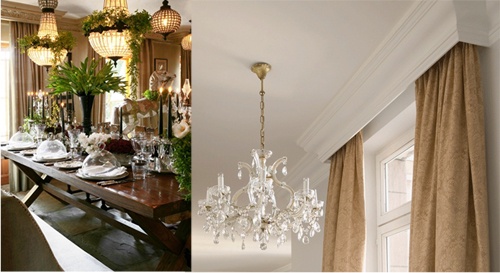
Installation of a drywall box
To carry out installation, you will need:
- Metal ceiling profile in size 27x60x3000 cm;
- The guide profiles are preferably from aluminum, it is forbidden to use wooden, size 28x27x3000 cm;
- Plasterboard sheet;
- Drill or screwdriver;
- Self -cutting screws (self -tapping screws) or brackets.
First of all, the sizes of the niche are marked into which it is planned to hide the cornice. To do this, measure the distance from the wall in which the window opening is located to the edge of the window sill or heating battery (in the event that the battery protrudes beyond the edge of the windowsill). Subsequently, 10 cm is added to it, which is the size of the allowance necessary for the free movement of curtains in the niche. In most cases, this distance should be at least 15 cm, which will facilitate the subsequent installation of the cornice, however, at the same time it should not exceed 20 cm. Further, using the masking cord, the line passing in parallel to the wall, which will be the edge of the niche.
Using a drill or screwdriver, the guide profiles are fixed on this line so that the step for dowels is at least 60 cm. In order to make the side sides of the box, previously chopped strips of drywall is screwed to the guide profiles. The step in this case is at least 15 cm. On the end sides of the box, the perimeter is marking and similarly fixed the guide box with the help of self -tapping screws. In this case, the profile should look towards the walls. Using a hacksaw, plasterboard stripes, which are simultaneously sidewalls of the niches, are trimmed along the profile. Careful processing of the ends is carried out with a shirt.
Using a ceiling profile, collect a crate, with a step of at least 40 cm. The drywall is cut along the width of the niche and the bottom of the box is sewn. As for the side walls of the niche, they can be made of glass or transparent plastic. Modern design solutions involve the manufacture of the edges of the box with curly in the form of waves or various geometric shapes. The width of the box is variable and depends on the height of the ceiling and the size of the room.
How to trim the drywall niche?
In the process of carrying out the skin, the screws are shed into drywall so that the hats do not protrude. They put putty joints and holes from screws. In case of need, putting the entire box can be put on. For putting internal corners, experts recommend using a rubber spatula.
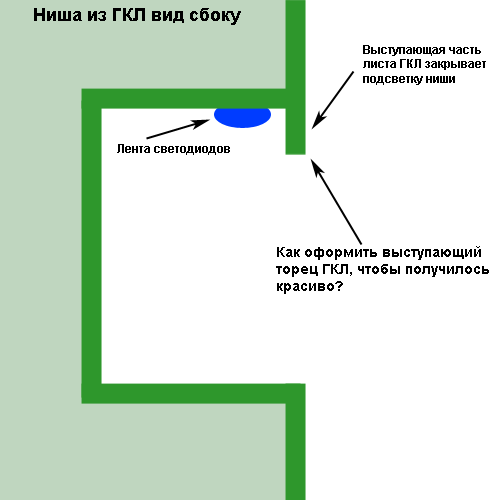
If you want to simplify the work on the final decoration of the box, after completing the work, decorate the internal corners of the box by applying plastic or metal corners on them. When performing putty work, the corner is pressed into the putty. At the end of these work, you will see that the angle turned out to be perfect. If you want to do without the use of the corner, thoroughly roll the edges of the drywall with sandpaper. After the final drying of the putty, emphasize the box with fine sandpaper. If you have carried out all the above events, you only have to remove the dust from the finished box and paint the niche.
If you want to add the interior of the room notes of mystery and originality, carry out the installation of the backlight for the niche from the drywall. For these purposes, halogen lamps are inserted into the box from the reverse side, creating multiple light, or neon tubes that will become a source of light adding comfort to the room. Having performed these actions, you will create a decorative element that can decorate any room. LED ribbons will emphasize the architectural features of the ceiling and a bright strip will highlight curtains in the air.

